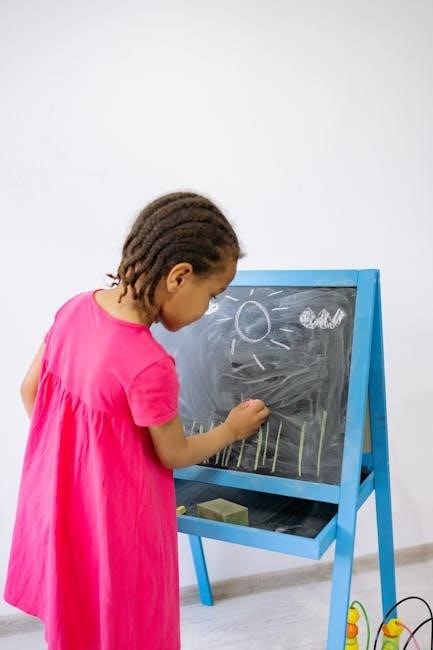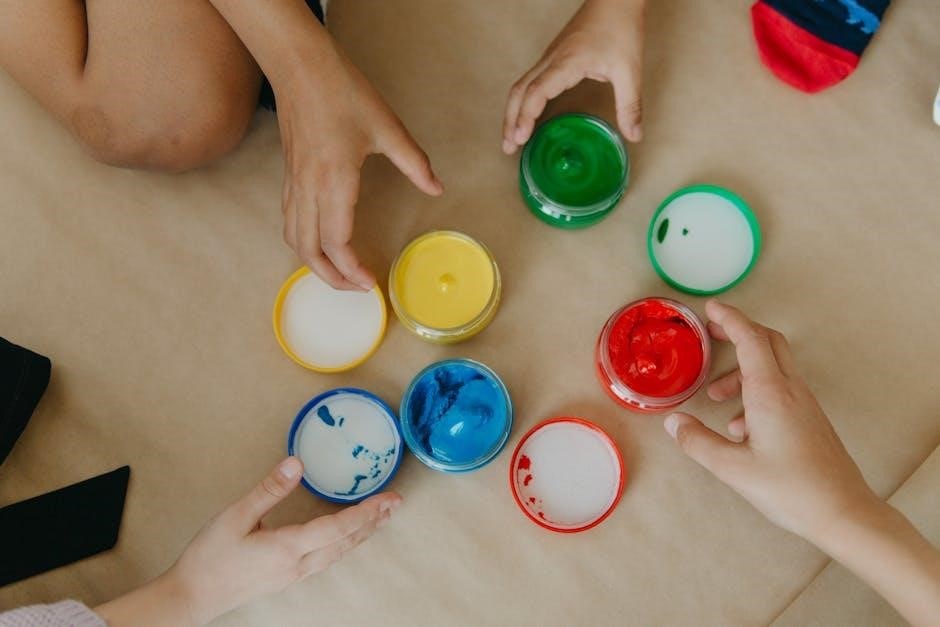Visual Motor Integration (VMI) activities enhance coordination between the eyes and hands‚ improving skills like handwriting and coordination. Activities include drawing‚ puzzles‚ and using scissors‚ fostering development in children. Regular practice strengthens these abilities‚ benefiting daily tasks and academic performance‚ especially with support from parents and educators.
Overview of Visual Motor Integration (VMI)
Visual Motor Integration (VMI) refers to the coordination between visual perception and motor skills‚ enabling individuals to process and respond to visual information effectively. It is crucial for tasks like handwriting‚ reading‚ and coordination. VMI involves the brain’s ability to integrate visual inputs with motor outputs‚ ensuring precise movements. Activities enhancing VMI include drawing‚ puzzles‚ and using scissors‚ which strengthen this connection. Early development of VMI is vital for academic success‚ as it supports school readiness and fine motor skills. Tools like the Beery-Buktenica Developmental Test assess VMI‚ identifying challenges. Interventions often involve play-based exercises to improve coordination and academic performance‚ making VMI a cornerstone of childhood development and learning.

Importance of VMI in Childhood Development
Visual Motor Integration (VMI) is a foundational skill critical for childhood development‚ enabling children to interpret visual information and respond with precise motor movements. It is essential for tasks like handwriting‚ reading‚ and coordination. Strong VMI skills promote school readiness and academic success‚ as they support fine motor abilities and cognitive development. Children with well-developed VMI often excel in activities requiring hand-eye coordination‚ such as drawing‚ cutting‚ and writing. Conversely‚ delays in VMI can lead to challenges in learning and daily tasks. Early identification and intervention through play-based activities‚ like puzzles or tracing‚ can significantly improve VMI‚ fostering confidence and competence in children. Parents and educators play a vital role in supporting VMI development‚ ensuring children have the tools needed to thrive academically and socially.

Defining Visual Motor Integration
Visual Motor Integration (VMI) is the coordination of visual perception and motor skills‚ crucial for tasks like writing and drawing. It enables interpreting visual information and responding with precise movements‚ essential for daily activities.
Understanding the Components of VMI

Visual Motor Integration (VMI) involves three key components: visual perception‚ motor skills‚ and the integration of these systems. Visual perception refers to how the brain processes and interprets visual information‚ such as recognizing shapes‚ patterns‚ and objects. Motor skills involve the ability to coordinate and execute physical movements‚ like using hands or fingers. The integration of these components enables the brain to guide movements based on visual information. For example‚ tasks like drawing‚ cutting with scissors‚ or catching a ball require VMI. Activities such as puzzles‚ tracing‚ and copying shapes can enhance these skills. Understanding these components helps identify areas where children may need support‚ ensuring proper development for tasks like handwriting and reading. Strengthening VMI is essential for academic success and daily functioning.
How VMI Impacts Daily Activities and Learning

Visual Motor Integration (VMI) plays a crucial role in daily activities and learning by enabling the brain to process visual information and guide physical movements effectively. Strong VMI skills are essential for tasks such as handwriting‚ reading‚ and problem-solving. For example‚ copying shapes or letters requires coordination between the eyes and hands‚ which is a fundamental VMI skill. Difficulties with VMI can lead to challenges in academic tasks‚ such as writing within lines or recognizing shapes‚ potentially affecting a child’s confidence and performance. Additionally‚ VMI impacts daily activities like using scissors‚ tying shoes‚ or playing sports‚ which rely on hand-eye coordination and motor precision. Enhancing VMI through targeted activities can significantly improve a child’s ability to perform these tasks‚ fostering independence and academic success.
Activities to Enhance Visual Motor Skills
Engage in activities like drawing‚ puzzles‚ and using scissors to improve hand-eye coordination. Play-based exercises‚ such as tracing shapes or coloring‚ also strengthen visual motor integration skills effectively.
Age-Specific VMI Activities for Children

Age-specific VMI activities are tailored to enhance visual motor skills in children at different developmental stages. For toddlers‚ simple tasks like finger painting or stacking blocks help refine hand-eye coordination. Preschoolers benefit from tracing shapes‚ coloring within lines‚ and puzzles to improve accuracy. School-age children can engage in mazes‚ cutting complex shapes with scissors‚ and writing exercises to strengthen integration. Adolescents can participate in detailed crafts‚ such as origami or drawing intricate patterns‚ to further develop their skills. These activities are designed to align with the child’s cognitive and motor abilities‚ ensuring a gradual and effective enhancement of visual motor integration. Consistent practice through play-based exercises fosters better coordination and prepares children for academic challenges like handwriting and reading.
Play-Based Activities for VMI Development
Play-based activities are an engaging and effective way to enhance visual motor integration (VMI) in children. These activities blend fun with skill development‚ making learning enjoyable. Examples include using spray bottles to clean surfaces‚ which improves hand-eye coordination and strength. Cutting through playdough or thick paper with scissors strengthens fine motor skills and enhances precision. Drawing or tracing shapes on whiteboards or paper fosters visual accuracy and control. Puzzles‚ mazes‚ and coloring within lines also contribute to better coordination and focus. These playful exercises are adaptable to different ages and skill levels‚ encouraging children to practice VMI without feeling pressured. By integrating play into learning‚ children develop essential motor and visual skills that are crucial for academic success and daily life.

Assessment and Tools for VMI
The Beery-Buktenica Developmental Test is a widely used tool to assess visual motor integration challenges. It evaluates how well visual and motor skills work together‚ ensuring early identification of developmental delays and providing targeted support for improved learning outcomes in children.

The Beery-Buktenica Developmental Test of Visual-Motor Integration
The Beery-Buktenica Developmental Test is a gold standard assessment for visual motor integration challenges. It evaluates how visual and motor skills work together‚ helping identify delays in children. The test involves copying shapes and designs‚ measuring accuracy and coordination. Results provide insights into a child’s ability to integrate visual and motor functions‚ crucial for skills like handwriting. Widely used by educators and therapists‚ it ensures early intervention and targeted support for improved learning outcomes. This tool is essential for understanding and addressing visual motor integration difficulties in both children and adults‚ promoting better academic and daily functioning.

Integrating VMI into Daily Life
Incorporate VMI activities into daily routines‚ such as drawing‚ puzzles‚ and using scissors‚ to enhance coordination and fine-motor skills naturally. These simple tasks promote development while being fun and engaging for children.
Strategies for Parents and Caregivers
Parents and caregivers play a vital role in fostering visual motor integration (VMI) skills in children. Simple‚ play-based activities like drawing‚ puzzles‚ and cutting with scissors can be incorporated into daily routines. Encourage tasks that require hand-eye coordination‚ such as using a spray bottle to clean surfaces or tracing shapes. Provide opportunities for practice‚ such as coloring within the lines or copying letters‚ to enhance fine-motor and visual skills. Create a structured environment where these activities are part of everyday play‚ making learning fun and engaging. Offering positive feedback and support helps build confidence and promotes steady progress in VMI development. Consistency and creativity are key to helping children thrive.

Implementing VMI Activities in Educational Settings
Integrating visual motor integration (VMI) activities into educational settings is essential for supporting students’ developmental needs. Teachers can incorporate VMI exercises into daily routines‚ such as tracing shapes‚ puzzles‚ or handwriting practice‚ to enhance coordination and focus. Group activities like drawing projects or crafts encourage collaboration while improving motor skills. Educators should tailor activities to meet diverse skill levels‚ ensuring all students can participate and benefit. Regular monitoring of progress helps identify areas for additional support. By embedding VMI activities into the curriculum‚ schools foster improved coordination‚ academic performance‚ and overall readiness for learning. These strategies create a foundation for long-term success‚ making VMI a vital component of holistic education.
Visual motor integration activities play a pivotal role in enhancing coordination and skill development‚ benefiting daily tasks and academic performance. Consistent practice and support from parents and educators ensure lasting improvements‚ making VMI a cornerstone of holistic growth and learning.
Final Thoughts on the Importance of VMI Activities
Visual motor integration (VMI) activities are essential for developing critical skills in children‚ such as handwriting‚ coordination‚ and problem-solving. These activities‚ including puzzles‚ drawing‚ and using scissors‚ strengthen the connection between visual perception and motor skills. Consistent practice enhances academic performance and daily functioning. Parents and educators play a vital role in implementing these activities‚ ensuring children achieve foundational abilities necessary for lifelong learning. By fostering VMI through play-based and age-specific tasks‚ we support overall developmental growth‚ making it a cornerstone of early childhood education and beyond.
